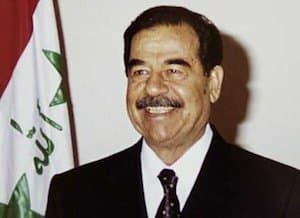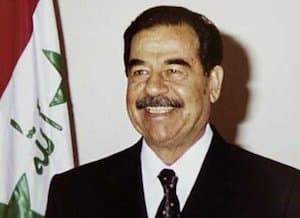The great Austrian economist Ludwig von Mises pointed out that one government intervention inevitably produces a crisis, which then causes government officials to enact a new intervention to address the crisis. The new intervention, however, produces a new crisis, which then necessitates a new intervention. With each new intervention, the government’s power continues to grow.
While Mises was referring to economic intervention, the principle applies in other areas. Good examples are the drug war, immigration controls, healthcare, and education, all areas that are characterized by a perpetual series of crises and interventions.
The principle also applies to foreign policy. Iraq provides a good example. Let’s examine the history of U.S. interventionism in Iraq.
1953: The U.S. government, operating through the CIA, knowingly, intentionally, and deliberately destroy Iran’s (Yes, Iran’s) experiment with democracy by ousting Mohammed Mossadegh from power in a coup and re-installing the Shah of Iran, who proceeded to establish one of the most brutal tyrannies in history, with the full support of the U.S. government. The reason for the coup? The British Empire had lost their oil rights in Iran and the U.S. government wanted to help Britain regain them. The ostensible reason for the coup was to save Iran from communism as part of the Cold War against the Soviet Union, the U.S. government’s World War II partner and ally.
1963: The U.S. government, again operating through the CIA, install the Baath Party into power in Iraq. A young member of the party is Saddam Hussein.
1979: The Iranian people violently revolt against the Shah’s tyrannical regime. Concerned that the U.S. government intends to reinstall the Shah into power and still angry over what the U.S. government had done 25 years earlier, Iranian revolutionaries take U.S. diplomats hostage, in violation of international law. U.S. officials play the innocent, telling the American people that the U.S. government has done nothing wrong to the Iranian people.
1980s: The U.S. government partners with Saddam Hussein, who is now president of Iraq, and furnishes him with chemical and biological weapons in the hope and with the aim that he will use these weapons of mass destruction (WMDs) to kill Iranians in Iraq’s war against Iran. Why did the U.S. government want Saddam to kill Iranians? Because U.S. officials were still angry with the Iranian people for ousting the Shah (which the U.S. government had installed into power) and for having taken U.S. diplomats hostage.
1991: The U.S. government, after expressing to its partner Saddam Hussein, an indifference toward his border dispute with Kuwait, dissolves the partnership and goes to war against Iraq. U.S. forces massacre thousands of Iraqi troops in a war that also kills countless civilians. The Pentagon intentionally destroys Iraq’s water and sewage treatment plants after conducting a study that shows that such action will help to spread infectious illnesses among the Iraqi people. The U.S. government also encourages Iraqi Shiites to rebel against Saddam. When they do, Saddam’s forces massacre them as U.S. forces watch.
1990s: The U.S. government establishes and enforces one of the most brutal sanctions regimes in history. The purpose of the sanctions is to squeeze the Iraqi people into ousting Saddam Hussein from power and installing a pro-U.S. ruler in his stead. The sanctions succeed in destroying the Iraqi middle class and fortify Saddam’s control over people’s economic affairs. Even worse, since the sanctions prevent Iraq from repairing the water and sewage treatment plants that the Pentagon had intentionally destroyed with the aim of spreading infectious illnesses, the death rate from infectious illnesses and malnutrition begin to soar, especially among Iraqi children. Year after year, for more than 10 years, the death toll mounts. So does ever-increasing anger and rage among people in the Middle East.
1993: The first terrorist attack on the World Trade Center. Convicted terrorist Ramzi Yousef angrily cites the U.S. government’s intentional killing of Iraqi children with the sanctions at his sentencing hearing in U.S. District Court.
1996: U.S. Ambassador to the United Nations Madeleine Albright tells “Sixty Minutes” that the deaths of half-a-million Iraqi children from the sanctions is “worth it.” By “it” she was obviously referring to the U.S. government’s efforts to oust Saddam Hussein from power and replace him with a pro-U.S. ruler
1996: Al Qaeda issues its fatwah against the United States, citing the deaths of 600,000 Iraqi children and other acts of U.S. government intervention in the Middle East.
1996: Terrorist attack on the USS Cole.
1998: Terrorist attacks on U.S. Embassies in Kenya and Tanzania.
2001: Terrorists strike the World Trade Center and the Pentagon.
2003: Given that the more than 10 years of sanctions and deaths of hundreds of thousands of Iraqi children had failed to oust Saddam from power, U.S. officials use the 9/11 attacks to scare the American people into supporting a war of aggression against Iraq, with the aim of accomplishing what the sanctions had not accomplished — the ouster of Saddam from power and his replacement with a pro-U.S. ruler.
Knowing that the United States had delivered chemical and biological weapons to Saddam in the 1980s, U.S. officials use those WMDs as a bogus way to garner support among the American people for an invasion. Scaring the American people into believing that Saddam was about to unleash WMDs, including nuclear mushroom clouds, on American cities, Americans overwhelmingly fall for the scheme and blindly and unconditionally support the U.S. government’s invasion of Iraq.
No WMDs are found. Nonetheless, Americans praise the troops and thank them for protecting their freedom, even though there is no evidence that Iraq posed any threat to their freedom. The rationale for invading and occupying Iraq is converted into one involving love for the Iraqi people — i.e., saving them from dictatorship and bringing them a paradise of freedom, peace, prosperity, and harmony. Americans continue to praise the troops and thank them for their benevolence. Hundreds of thousands of Iraqis are killed, maimed, or tortured during the occupation. There is never an upward limit on the number of Iraqis who could be killed in the process of bringing them their U.S.-provided model society.
2008: U.S. forces find WMDs in Iraq in the form of old, rusted out canisters containing mustard gas and sarin, and other chemical weapons. U.S. officials order U.S. troops, including those who are injured by the WMDs, to keep the find secret from the American people. Why secret? To prevent the American people from discovering that these were the chemical and biological weapons that the U.S. government had furnished Saddam Hussein during the 1980s so that he could use them to kill Iranians, and which the U.S. government had used as the bogus means to scare Americans into supporting the U.S. invasion of Iraq in 2003. The U.S. government expresses indifference to the U.S. soldiers who are wounded by the U.S.-provided WMDs.
2011: U.S. troops exit Iraq, leaving a society ruled by a brutal pro-Iranian dictatorship, one that imposes the same type of tyranny that Saddam Hussein imposed, albeit with a different set of victims.
2014: The U.S. sends U.S. troops back into Iraq and initiates a new bombing campaign in Iraq, this time against the Islamic State, which consists largely of people who served in Saddam Hussein’s government, the government ruled by the political party that the U.S. government installed into power in 1963 and ultimately headed by Saddam Hussein, the U.S. government’s partner during the 1980s to whom they delivered WMDs so that he could use them to kill Iranians, who had audaciously ousted from power the Iranian tyrant the Shah of Iran, whom the U.S. government had installed into power in 1953 in order to restore oil rights to the British Empire.
Reprinted with permission from the Future of Freedom Foundation.


